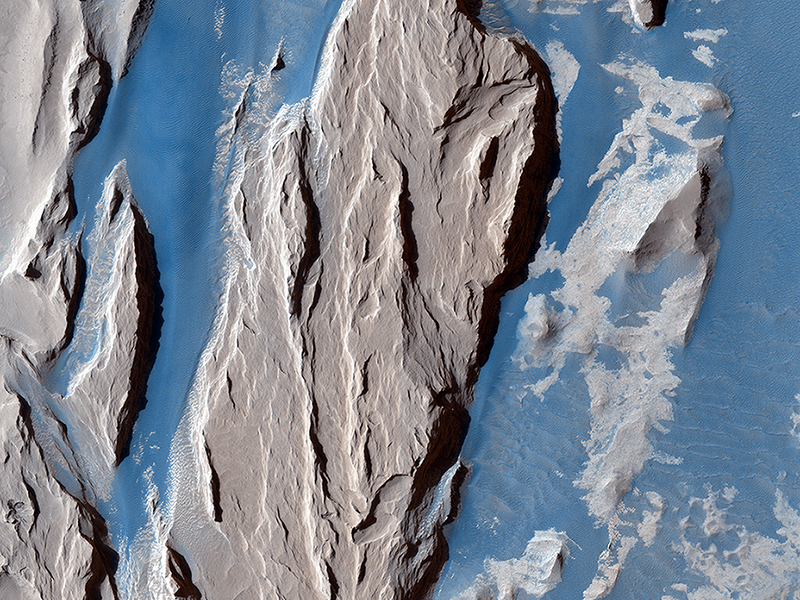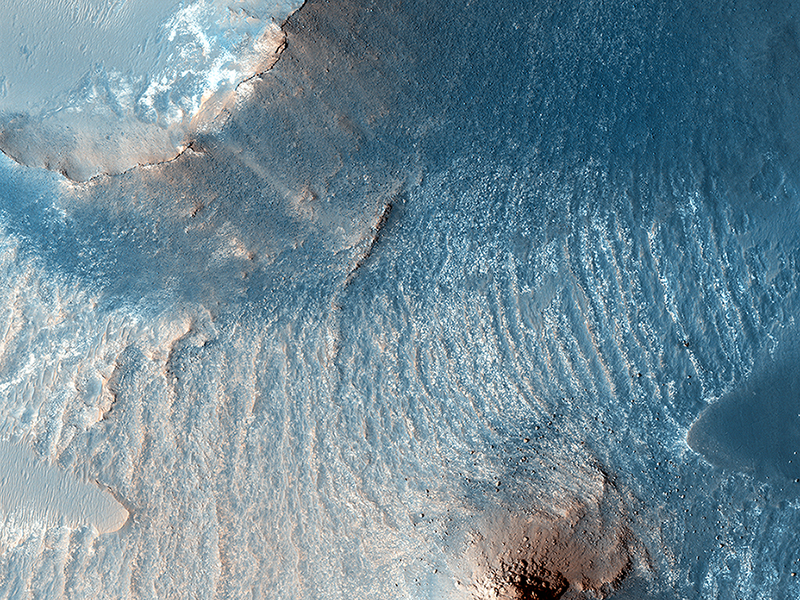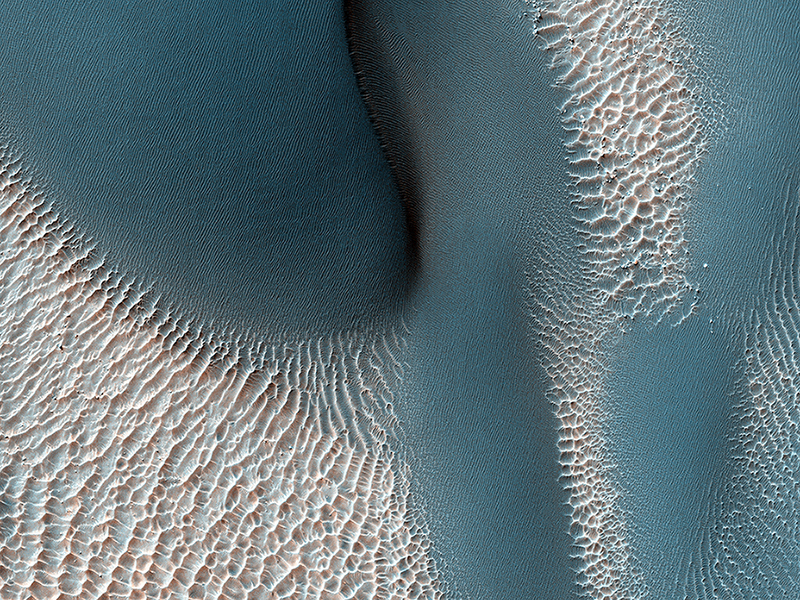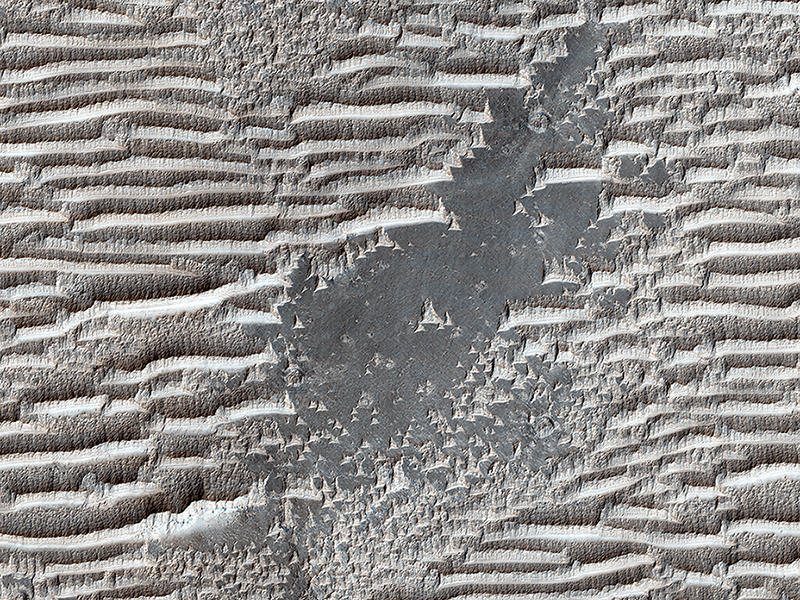HiRISE Updates (2015 Sep 16)
Posted: Wed Sep 23, 2015 4:21 am
Livio Tornabene, Elizabeth Silber, and Kayle Hansen wrote:Western Medusa Fossae Formation: Dust and Dunes (ESP_041864_1745) (HiClip)
This beautifully contrasted infrared-color image shows an area approximately 600 by 900 meters. This is a close-up of the western Medusa Fossae formation where we can see dust-covered rocky, bedrock surfaces (beige) and a bluish-tinted sand sheet that transitions into several dunes.
The bluish sand is thought to originate from the bedrock that lies beneath the dust. If true, this has implications for the composition of the formation, which has been highly debated over the years.
Kayle Hansen, Livio Tornabene, and Elizabeth Silber wrote:Possible Sulfates in the Northeast Syrtis Major Region (ESP_041893_1975) (HiClip)
A variety of diverse morphological features are present in this image (21 by 5.5 kilometers) located in the southeastern area of the Nili Fossae region and just northeast of Syrtis Major.
This particular region has been studied intensely due to the presence of volcanics from Syrtis Major and impact ejecta from the Isidis Basin. The region is rich in unaltered mafic deposits, in contact with diverse altered deposits rich in clays, carbonates, and sulfates. These deposits make the Nili Fossae region one of the most colorful regions on Mars, which is most distinctive in infrared color composites (IRB). HiRISE IRB color aids in chemical and mineral-type mapping, especially when correlated with other MRO instruments such as CRISM.
In this infrared color close-up image (2.6 by 1.2 kilometers), we can see a mesa, along with aeolian dunes and yellow-colored deposits. A mesa is a flat, steep-sloped hill, which was likely eroded by a combination of wind-driven and landslide processes. These are often formed due to differing rock compositions, which vary in their resistance to erosion, e.g., a weaker and softer rock, such as sediments, lies beneath a stronger and more resistant rock. The flat top surfaces of mesas, termed the “cap” rock, are relatively erosion-resistant rock types, such as igneous lavas or intrusive sills. The looser, yellowish deposits that underlie the cap rock contrast nicely with the purplish-blue cap rock.
Another closeup (0.7 by 1.2 kilometer) shows an area just north of the mesa that is particularly distinct in this IRB color. Based on a corresponding CRISM image providing spectral data, there is some exposed bedrock in the area that likely contains salt-bearing rocks.
This is a stereo pair with ESP_041115_1975.
Paul Geissler wrote:Which Came First? (ESP_042040_1275) (HiClip)
The workings of the Martian winds are visible in this image of sand dunes trapped inside an unnamed crater in southern Terra Cimmeria.
Many of the craters in the Southern highlands of Mars contain sand dunes, and HiRISE is still in the process of mapping these dunes and determining how active they are today. So far, the dunes in these craters appear to be a mixed bunch, with some dunes actively advancing while others seem to be frozen in place. This image will be compared to a previous picture, to see how these dunes have changed since 2008.
The sand dunes are the large, branched ridges and dark patches that are conspicuous against the bright background, particularly in the northwest corner of our picture. There are also signs of two other wind-related processes: smaller, brighter ridges line the floor of the crater in regularly spaced rows. These are also windblown deposits, mysterious “transverse aeolian ridges” or TARs that are more common in the Martian tropics. Faint, irregular dark lines cross the dunes and the TARs, marking the tracks of dust devils that vacuum the surface during southern summer. So, which came first? We can untangle the history of these processes by looking at the picture more closely.
Over most of the image, it is obvious that the dark sand dunes bury the bright TARs, meaning that the sand dunes are younger than the TARs. But this relationship is not so clear for the southernmost dune we see in this picture. Here, the TARs look like they extend into the dune and merge with ripples on the dune’s surface, suggesting that the TARs might be younger than the dunes. The question can be resolved by carefully examining an enhanced color cutout. The TARs are brighter and redder than the sand dunes and this color persists on the crests of the TARs as the sand encroaches, burying the valleys first and then the slopes and finally the TAR crests. This tells us that the unusual appearance of the dune margin is caused by burial and exposure of the older TARs by the younger sand. Finally, you can trace the tracks of dust devils crossing over the dunes, telling us that they are younger than the dunes.
So, first came the TARs, next the dunes, and last the dust devils — probably within the last few months!
Paul Geissler wrote:Bizarre TARs (ESP_042124_1665) (HiClip)
These strange features in Syria Planum are still being widely debated. They have the same general form as transverse aeolian ridges (TARs) elsewhere on Mars; windblown deposits that are common in the Martian tropics. Their height and spacing are similar to the more familiar looking TARs in other places, and they are similarly bright. Unless Nature is perverse, they were both made by the same process.
Yet the TARs here in Syria Planum appear different than typical TARs elsewhere on the planet. They have blunt edges, in contrast to the tapering ends of typical TARs. The ridge crests are serrated, unlike the smooth crests of most TARs. They are layered on their upwind faces and scoured on the downwind sides, whereas TARs are usually smooth and symmetric. Why are these TARs bizarre?
A possible answer is that the features here in Syria Planum are at a different stage of evolution than TARs elsewhere, and are either younger or older than typical TARs. We can look at an enhanced color cutout to see whether this can be the case.
Our cutout covers the width of the color strip (1 kilometer) and is centered on a bare patch in a field of bright TARs. The illumination direction is from the top left, and the wind direction is from top to bottom. At first glance, these TARs look like they could be old, degraded versions of the TARs with which we are familiar. However, erosion tends to smooth things out and not create sharp edges where none existed previously. More likely, we are seeing TARs in the process of formation. The distinctive features of the TARs in Syria Planum — the blunt edges, serrated ridges, and the asymmetric appearance of the surface — are features that are more easily removed than created by erosion.
Credit: NASA/JPL/University of Arizona
<< Previous HiRISE Update



